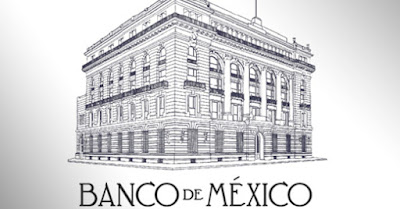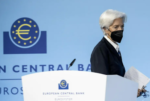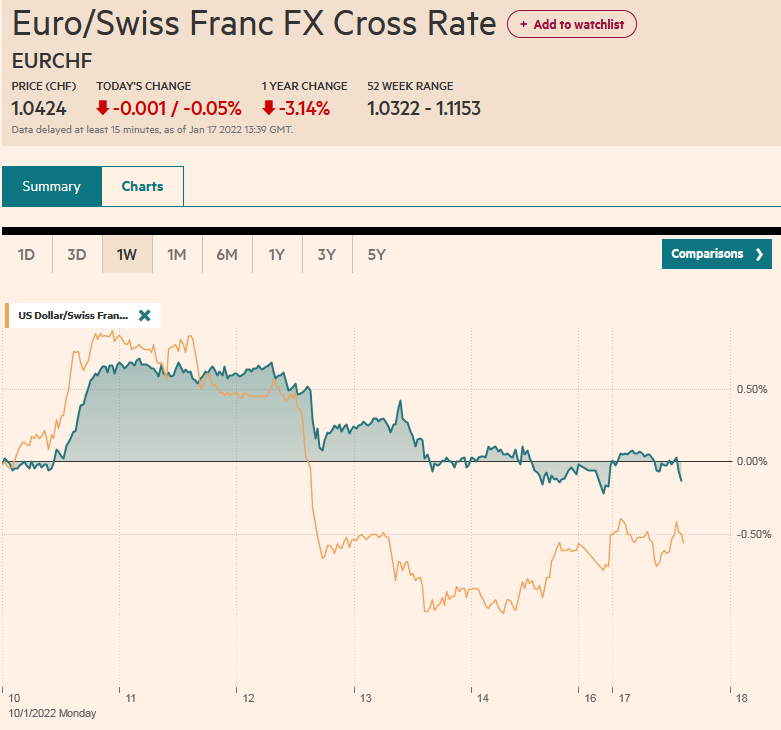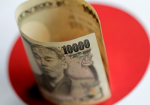Overview: Global equities are bleeding lower. Several large markets in the Asia Pacific region, including Hong Kong, Taiwan, and India are off more than 2%. Japan and Australian bourses fell by more than 1.5%. Europe's Stoxx 600 is off more than 2% and giving back the gains recorded in the past two sessions plus some. US futures are extending yesterday's loses. The sharp sell-off of equities has given the sovereign bond market a strong bid. The 10-year US Treasury yield that had approached 3.20% on Monday has tumbled to 2.81% today. The 2-year yield had approached 2.75% yesterday after the disappointing CPI report. It is now around 2.57%. European 10-year benchmark yields are 10-14 bp lower. The dollar is flying, except against the Japanese yen. The Antipodeans
Topics:
Marc Chandler considers the following as important: 4.) Marc to Market, 4) FX Trends, China, Currency Movement, ECB, Featured, Federal Reserve, inflation, Japan, newsletter, U.K., USD
This could be interesting, too:
Nachrichten Ticker - www.finanzen.ch writes Die Performance der Kryptowährungen in KW 9: Das hat sich bei Bitcoin, Ether & Co. getan
Nachrichten Ticker - www.finanzen.ch writes Wer verbirgt sich hinter der Ethereum-Technologie?
Martin Hartmann writes Eine Analyse nach den Lehren von Milton Friedman
Marc Chandler writes March 2025 Monthly
Overview: Global equities are bleeding lower. Several large markets in the Asia Pacific region, including Hong Kong, Taiwan, and India are off more than 2%. Japan and Australian bourses fell by more than 1.5%. Europe's Stoxx 600 is off more than 2% and giving back the gains recorded in the past two sessions plus some. US futures are extending yesterday's loses. The sharp sell-off of equities has given the sovereign bond market a strong bid. The 10-year US Treasury yield that had approached 3.20% on Monday has tumbled to 2.81% today. The 2-year yield had approached 2.75% yesterday after the disappointing CPI report. It is now around 2.57%. European 10-year benchmark yields are 10-14 bp lower. The dollar is flying, except against the Japanese yen. The Antipodeans and Norwegian krone are getting tagged more than 1% today. The euro and sterling have been sold to new lows. Emerging market currencies are a sea of red too. Hungary, which kept its one-week deposit unchanged, has seen the biggest hit, off almost 1.5% today, while the Chinese yuan is off by slightly more than 1%, which is a large move for it. The Hong Kong Monetary Authority intervened to defend its peg for the first time in three years. Gold is heavy, after recovering from a three-month low yesterday near $1832. It is hovering a little below $1850 near midday in Europe. June WTI is trading with a lower bias ahead of the OPEC and IEA reports. US natgas is off almost 3% after gaining more than 8.5% over the past two sessions. Disruptions of Russian gas to Ukraine has seen Europe's benchmark jump by more than 13% today. Iron ore, which snapped a three-day slide yesterday with a 4.2% jump is off nearly 5% today. Similarly, June copper rose for the first time in five sessions yesterday. However, today's 3.6% plunge more than offset yesterday's 1.3% gain. July wheat prices are little changed ahead of the US World Agriculture Supply and Demand Estimate report.
Asia Pacific
China's fourth largest property developer, Sunac, has defaulted on a dollar bond, according to reports, adding to the angst emanating from Beijing. New Covid cases in Shanghai means the lockdown will continue. The restrictions are estimated to cover around a third of the country's GDP. A PBOC indicated that it is guiding rates lower. The benchmark 1-year medium-term lending rate may be set on Monday. It stands at 2.85%. The market was disappointed that there was no reduction last month and does not want to be bit by the same dog twice and most look for it to be unchanged. Next week Chinese officials will meet with tech companies and there is hope that the crackdown will end.
Japan is suffering from a terms-of-trade shock as the prices of imports have soared compared with exports. However, the broader measure, the current account surplus swelled in March to JPY2.55 trillion from JPY1.65 trillion and well above expectations (median forecast in Bloomberg's survey was JPY1.75 trillion. They key, as we have argued, is the primary income, which is the return on past investment, such as interest, dividends, re-invested earnings, royalties, and licensing fees. The weakness of the yen boosts the value of these foreign earnings. On balance-of-payment terms, Japan recorded a trade deficit of JPY166 bln, a little smaller than in February but larger than expected. Japanese figures which do not always jive with the US Treasury data, showed Japanese investors were sellers of JPY2.9 trillion of US government bonds in March, the sixth consecutive month this time series has recorded sales. Canadian, British, German, and Italian bonds were also sold in March. Japanese investors looked kinder toward Australian, French, and Dutch bonds.
The continued drop in US Treasury yields has seen the dollar slump against the Japanese yen. The greenback has been sold to new lows for the month near JPY128.40. It has broken the 20-day moving average (~JPY129) for the first time since early March. A break of the JPY128.30 area could signal a move toward JPY127.00. The Australian dollar has broken down and is trading at new lows since mid-2020, pushing below $0.6900. After rising to around $0.7055 yesterday, the Aussie reversed sharply lower and settled near $0.6940. The next significant chart area is closer to $0.6760, which corresponds to the (50%) retracement of the gains from March 2020 low around $0.5500. The greenback rose to almost CNY6.79 as it broke higher out of the consolidative phase seen earlier this week. It is the strongest level of the US dollar since last October. We suggest the next target is around CNY6.82. For the eighth consecutive session, the PBOC set the dollar's reference rate lower than expected (Bloomberg survey). The fix was at CNY6.7292, while the market anticipated CNY6.7341. Given that the greenback is allowed to move 2% from the fixing, the lower dollar reference rate is a means of moderating the dollar's move higher.
Europe
Many observers think that ECB President Lagarde cast her lot in favor a July rate hike yesterday. However, it does not look like she really said anything new. As she said in her speech, she has been very clear that "sometime" in the context of raising rates after bond buying stops, could be a matter of weeks. That sounds more like a central banker trying to preserve some flexibility. The operative word is "could". As Fed Governor Waller, the market, understanding the communication of officials began taking rates up (and tightening financial conditions) six months before the central bank began increasing rates. Consider that on October 1 last year, the implied yield of the December 2022 Eurodollar futures (yield on three-month time deposit) was 0.47%. On the eve of the FOMC's decision to hike rates in mid-March, the yield had already risen to nearly 2.15%. The December 2022 Euribor futures contract had an implied yield of negative 27.5 bp on March 1. It has risen to 76 bp by the start of this week but has pulled back to around 56 bp today.
The UK disappointed. The economy unexpectedly contracted by 0.1% in March. Industrial output and services fell, and the trade deficit worsened. The net impact was to shave Q1 growth to 0.8% quarter-over-quarter, compared with expectations for a 1% expansion. The quarterly figures showed private consumption was weaker than expected (0.6% vs expectations for 0.9%). Foreign demand for British goods was also weak (exports fell by almost 5% quarter-over-quarter). Among the biggest surprises, though, was the 1.7% contraction in government spending (quarter-over-quarter). Economists in Bloomberg's survey had forecast a 0.5% expansion.
Draghi seems to be moving into a vacuum created by the ambiguous signals from the EC. An agreement to ban Russian oil has not been agreed upon let alone gas. Yet, the EC has suggested that paying roubles for Russian energy violates the sanctions. It has nevertheless been sufficiently vague that the no-EU skeptic Draghi said it was a "gray area" and noted that many gas importers have opened a rouble account with Gazprombank. The idea, recall, is that the contracts specify payment in euros, but the sanctions make it difficult to use the euros. Putin demanded that European customers have two accounts with Gazprombank, which is still on SWIFT messaging system. One is in euros and the customer pays into that. Gazprombank will make the necessary conversion and credit the rouble account. The rouble account will be drawn down to pay for the oil.
The two-week consolidation pattern that had confined the euro has been resolved to the downside. The single currency has fallen to almost $1.0420 in the European morning. The next target are the lows from late 2016/early 2017 around $1.0340. On the upside, the $1.0480-$1.0500 area offers the nearby cap now. Sterling has been sold to a new two-year low near $1.2165. The next chart area of interest is by $1.2080, but the $1.20 area may offer stronger support. The intrasession momentum studies are extended for both the euro and sterling. However, neither is particularly close to the lower Bollinger Band (~$1.0370 and $1.2045, respectively).
America
While the US April CPI was a bit firmer than expected, it is not a game changer. First, it is not like it is a precision machine tool that can be measured in fractions of the diameter of a human hair. Second, the Fed funds futures for the next two meetings were practically unchanged from the day before, and the market remains less convinced that Fed will go another 50 bp hike in September. Consider that the October Fed funds futures contract had an implied yield of about 2.37% on the eve of the Fed's announcement. Yesterday, after the CPI data and the recent Fed-speak, the contract was implying around 2.26%. Third, the composition of measured inflation. Used car prices, which a source of consternation last year, have fallen for three consecutive months. On the other hand, new car price rose 1.1%, the most this year. While food and energy prices rose, the core rose more than the headline. Part of this is airfares jumped 18.6%, which may be worth 0.1-0.2 percentage points of the core rate's 0.6% increase. Some part of this is likely reflecting higher energy prices too. Housing accounts for a little more than 40% of the CPI basket and costs rose by 0.6%. That is essentially the average this year. Without some moderation, CPI is likely to be sticky. Finally, the eight-basis point increase in the 10-year breakeven needs to be placed in the context of it having fallen by more than 20 bp Monday and Tuesday. The point is that it is still lower on the week, and if sustained, would be the first weekly back-to-back decline in four months. Meanwhile, the Senate has confirmed Philip Jefferson as Governor on the Federal Reserve and Lori Logan will become the next president of the Dallas Federal Reserve in August.
The central bank of Mexico meets today. Only one of 23 surveyed by Bloomberg does not expect a 50 bp hike, and its forecast is for 75 bp. It is not that growth is particularly strong in Mexico or that there is much fiscal support. Instead, the challenge is inflation. It has accelerated. The headline rate has averaged 0.74% a month this year compared with 0.66% average in the January-April 2021 period. The core rate has averaged a monthly increase of 0.72% this year after 0.41% in the first four months of last year. A 50 bp hike by Banxico would lift the overnight target rate to 7%. Headline inflation is nearly 7.7% and the core is slightly more than 7.2%. The swaps market is pricing in 110 bp of tightening over the next three months, suggesting some risk of more than a 50 bp move, perhaps if the Fed opts for a quicker pace.
The risk-off environment continues to weigh on the Canadian dollar. The US dollar has been confined to yesterday’s range when it traded just shy of CAD1.3040. Support is seen near CAD1.2980. We want to be sensitive to the possible weakening of the near-lockstep movement of the exchange rate and US equities. It will take more than one session to weaken that strong correlation we have documented. The greenback is hovering around CAD1.3025, which is the (38.2%) retracement of the decline from the March 2020 high (~CAD1.4670). The next retracement (50%) is close to CAD1.3340. The US dollar is also knocking on yesterday's high against the Mexican peso (~MXN20.4670). At the end of April, the greenback tested the MXN20.64 area and that seems to be the next target. A move above there could spur a move toward MXN20.80.
Tags: #USD,China,Currency Movement,ECB,Featured,federal-reserve,inflation,Japan,newsletter,U.K.








